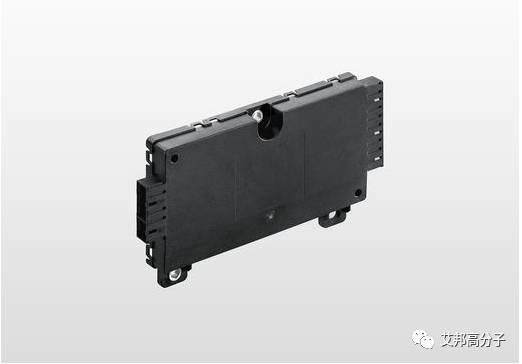特殊化学品公司朗盛和德国海拉胡克集团公司合作开发了一种名为Pocan AF4130的新型复合材料,用作电池管理单元(BMU)和两个单元监控单元(CMU)的外壳材料。
聚对苯二甲酸丁二醇酯(PBT)和丙烯酸酯-苯乙烯-丙烯腈(ASA)的共混物含有30%(按重量计算)的玻璃纤维和卤素阻燃剂包。该材料的特殊优点是其极低的翘曲和收缩,加上其高阻燃性。Lanxess高性能材料(HPM)业务部门的销售总监Marc Marbach表示:“我们认为这种材料在汽车电池系统精密零部件的应用潜力很大。”从最初的想法到广泛的测试,再到可以用于全面的生产,只用了两年半的时间。
海拉为德国汽车电池制造商生产BMU和CMU。目前这种非常平坦的设备正在德国小型车的锂离子电池系统中使用。

图 海拉为德国汽车电池制造商生产BMU和CMU
偏差低
BMU和CMU的外壳具有大的平坦表面以及具有复杂几何形状的边缘和内部。由于其创新的设计,BMU和CMU的外壳可以成本有效地作为单一组件注塑成型。当外壳安装在印刷电路板上时,连接器的接触端不能混在一起。因此,连接器支架与插脚的切口之间的间距公差是非常接近的。“这正是我们的混合物Pocan AF4130出色的尺寸稳定性所在。”Marbach解释说。
UL 94 5VA和UL f1
该材料在美国测试机构保险商实验室公司的UL94防火测试中获得了V-0(0.75毫米)的最佳阻燃等级。UL黄卡上也显示该材料UL94防火等级为5VA(1.5mm)。
该材料用于阻燃外壳部件的注射成型。另外UL f1数据显示,该材料还可用于涉及暴露于UV光线和水的户外应用中。Marbach补充说:“我们的复合材料也可用于光伏插头和插座之类的电气部件上。”
低挥发性和可容许范围内的排放量
Lanxess根据VDA 278标准(德国汽车工业协会)进行的热解吸分析所证明的,这种材料表面由热塑性塑料制作成型,排放非常低。“因此,它也适用于需要非常低挥发性和可容许范围内排放的许多汽车应用,例如汽车内饰部。”Marbach表示。
对常见电池电解质有良好的抵抗性
该混合物对机动车辆中使用的典型介质(如燃料,油,清洁剂和汽车护理产品)具有很强的抵抗能力,这在Lanxess为海拉胡克进行的广泛的介质储存测试中得到证实,符合供应规范LV 124,这一被许多汽车制造商认定的标准。该材料还显示出对广泛用于锂离子电池的电解质的良好抗性,对此也按DIN EN22088-3进行了负载测试。“样品即使在1,000小时的曝光后也没有明显的裂缝,还可以使用。”Marbach表示。
综合性的HiAnt服务
Lanxess在研发外壳组件方面为海拉胡克提供了额外的支持。这些服务是HiAnt客户服务包的一部分。例如,HPM提供了优化组件设计的建议,提供所有外壳组件电脑辅助设计是需要的材料性能数据以满足预期负载并进行模流分析,帮助进行起初的注塑成型试验。这家特种化学品公司进一步通过离子色谱法为Hella确定了混合物中卤化物含量,并对VDA 270进行了气味测试。
LANXESS launches new PBT compound for battery components in electric cars Specialty chemicals company LANXESS has developed a new compound called Pocan AF4130 in collaboration with HELLA KGaA Hueck & Co., based in Lippstadt, Germany. It serves as a housing material for a battery management unit (BMU) and two cell monitoring units (CMU). The blend of polybutylene terephthalate (PBT) and acrylic ester-styrene-acrylonitrile (ASA) contains 30 percent by weight glass fibers and a halogen-based flame retardance package. “The particular advantages of the material are its extremely low warpage and shrinkage, combined with its high flame retardance. We see great potential for application in precision components for vehicle battery systems,” says Marc Marbach, head of Sales Segments E&E in the LANXESS High Performance Materials (HPM) business unit. It took just two-and-a-half years to go from the initial idea to extensive testing and finally to use in full-scale production. HELLA fabricates the BMU and CMUs for a German manufacturer of battery systems for motor vehicles. The very flat devices currently are used in the lithium-ion battery system of a German compact car. Low tolerances The housings of the BMU and CMUs have large, flat surfaces as well as complex geometries along the edges and on the inside. Thanks to their innovative design, they can be injection molded cost-effectively as single components. The contact pins for the connectors must not bend when the housings are mounted on the printed circuit boards. The tolerances for the spacing between the connector mounts and the cut-outs for the pins are therefore extremely close. “This is precisely where the outstanding dimensional stability of our blend Pocan AF4130 pays off,” explains Marbach. UL 94 5VA- and UL f1-listed As required for this application, the material achieves the best classification of V-0 (0.75 millimeters) in UL 94 fire testing by the U.S. testing organization Underwriters Laboratories Inc. It further is listed on the UL Yellow Card with a good classification of UL 94 5VA (1.5 millimeters). The material is destined for the injection molding of flame-retardant housing components. It additionally has been given a UL f1 listing for use in outdoor applications involving exposure to UV light and water. “Our compound thus has a good chance of also being used for electrical components such as photovoltaic plugs and sockets,” says Marbach. Low volatile and condensable emissions Surfaces made of this thermoplastic are very low-emission, as demonstrated by thermal desorption analyses conducted by LANXESS in accordance with VDA 278 (German Association of the Automotive Industry). “It is therefore also suitable for many motor vehicle applications requiring very low volatile and condensable emissions, such as components for the automotive interior,” says Marbach. Good resistance to common battery electrolytes The blend is highly resistant to typical media used in motor vehicles, such as fuels, oils, cleansers and car care products, as proven in extensive media storage tests conducted by LANXESS for HELLA in accordance with the supply specification LV 124, used by many automotive manufacturers. It also displays good resistance to an electrolyte widely used in lithium-ion batteries. The corresponding test was additionally conducted under load in compliance with DIN EN 22088-3. “No cracks were evident in the samples even after 1,000 hours of exposure,” explains Marbach. Comprehensive HiAnt services LANXESS provided HELLA with extensive support in developing the housing components. These services are part of its HiAnt customer service package. For example, HPM delivered suggestions for optimal component design, provided all the characteristic material data required for the computer-aided design of the housing parts to meet expected loads and for the mold flow analyses, and supported the initial injection molding trials. The specialty chemicals company further determined the blend’s halogenide content for HELLA by means of ion chromatography and conducted odor testing to VDA 270. |
英文信息来源:https://lanxess.com/,艾邦高分子编辑整理。
#标签#材料,资讯#
一起加入汽车材料群讨论吧,群主微信:abgfz-zero

长按二维码一起加入汽车材料群讨论吧
推荐阅读:

阅读原文申请加入汽车材料群
始发于微信公众号:艾邦高分子



